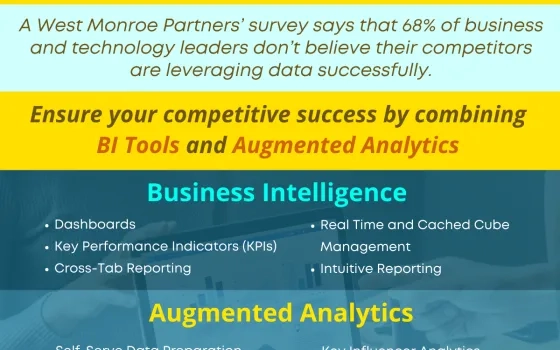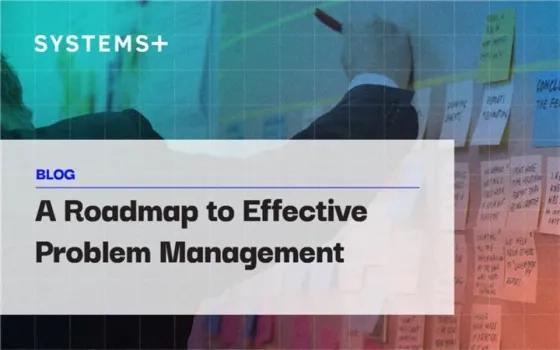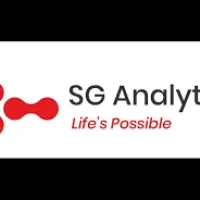According to a West Monroe Partners’ survey, 68% of business and technology leaders surveyed don’t believe their competitors are leveraging data successfully. Obviously, when it comes to your competitive market space, your business does not want to exist in that 68% of the pie chart! Your senior execs and managers want to leverage data and information to gain a competitive advantage and succeed.
Recent studies have focused on the trends in business intelligence and augmented analytics, predicting that businesses will grow analytics within the enterprise with:
- Augmented Analytics to enable non-technical business users to create sophisticated data models.
- Data Privacy to ensure government and industry regulations are in compliance as business users adopt self-serve BI tools
- Self-Serve Business Intelligence that integrates data from disparate data sources and makes it available for mobile access
- Social BI Tools that allow for sharing of data, alerts, dashboards and interactivity to support decisions, enable online communication and collaboration.
- Data Discovery including self-serve data preparation, smart data visualization with charts, graphs and other visualizations for clarity and decisions.
- Predictive Modeling to support business needs, forecast, and test theories.
- Embedded BI to allow users to sign in to familiar enterprise apps and leverage APIs to integrate analytics within that application for intuitive use.
- Cloud and Mobile Access to make business intelligence, data models and data sources accessible from anywhere.
As you review the list of predictions above, note that traditional and modern BI tools and Augmented Analytics with Natural Language Processing (NLP) and machine learning seems destined to co-exist for the foreseeable future. Each of these approaches provides a unique and critical support foundation for business users and for the organization.
‘When considering all the features and functionality you want for your business, you must also be aware that it will be more cost effective and timely to select a BI tool and an augmented analytics solution that do not require custom integration or separate maintenance and support approaches.’
In this article, we will discuss the importance of Business Intelligence and Augmented Analytics and a few select factors the business should consider when choosing a service provider or vendor solution.
Traditional business intelligence is focused on reporting and queries, whereas advanced analytics is focused on the analysis of structured and unstructured data to optimize, correlate and predict the activities and strategies that will help the business succeed and to predict results.
Business Intelligence
Dashboards - A BI tool is crucial for business users to monitor and present data. Business users should have the ability to design personalized dashboards in minutes, without knowledge of any programming or SQL queries. Users should have access to stunning visualizations, alerts for exceptions and trends, and deep dive analysis using highly interactive dashboards. When reviewing your BI tools options, avoid static, restrictive packages and look for a tool that will allow business users the ability to use interactive, self-serve dashboards for deep dive capability.
Key Performance Indicators (KPIs) – KPIs allow the business to establish and monitor KPIs for objective metrics. Users must be able to define KPIs with an easy to use, powerful expression engine and set polarity, frequency, and threshold levels using a browse- based interface. KPI Analytics provide interactive options to change frequencies, dimension break downs and drill down to further analyze trends, and reasons for performance and non performance.
Cross-Tab Reporting [SO1] - Business users need easy-to-use, flexible tools that will allow for Cross-tab analytics offers a 360 degree view of your multi-dimensional data with ad-hoc queries and BI reporting so you can take full advantage of Business Intelligence with a clear view of corporate performance and ability to slice and dice data, drill down, drill up and drill through to find the most relevant Information.
Real Time and Cached Cube Management – Business users need flexible options for data access and management so you can choose the option that is best for your use case scenario. You should be able to connect to data sources using simple wizard-based connection interface. Real-time cube management connects to data sources in real time, and compiles data for fast performance to deliver real time analytics to users. Cached cube management provides high performance analytics on pre-aggregated data and provides other computations for superior performance and analytics, refreshing data from data sources at a defined frequency.
Intuitive Reporting – Your business needs web-based BI reports that are simple to use, practical to implement and affordable for every organization. Users should be able to point-and-click and drag-and-drop and instantly create a report to summarize your performance metrics, or operational data, all in a self-serve environment without programming or database or SQL skills and automate publication and delivery of these reports via email, thereby improving productivity and ensuring that information reaches the right people at the right time.
Augmented Analytics
Self-Serve Data Preparation - Users with average skills can perform data preparation and transform, shape, reduce, combine, explore, clean, sample and aggregate data, without the need for SQL skills, ETL or other programming language.
Assisted Predictive Modeling – Users get predictive modeling capability assisted by auto-recommendations and auto-suggestions to simplify use and allow business users to leverage predictive algorithms without the expertise and skill of a data scientist. Users can apply predictive analytics to any use case using forecasting, regression, classification, clustering and other algorithms.
Smart Data Visualization –Business users can interact easily with data discovery tools and analytics software and build a view that will tell a story using guided visualization and recommended data presentation so there is no need for assistance or delays. Guided recommendations are made based on data type, volume, dimensions, patterns and nature of data.
Sentiment Analysis – Users can leverage Natural Language Processing (NLP), text analytics, and computational linguistics to identify and analyze sentiment, opinion and responses and can be used for text analysis to gain insight into how and why people make choices and what they are really thinking and categorize feedback as positive, negative and neutral sentiments. The process is simple, and is designed for business users, and does not need any scripting or coding.
Key Influencer Analytics - Focus on what matters and find the most relevant influencers for your target KPIs. Business users often find it difficult to identify the right targets and to understand relationships and factors that influence results. Point to the dataset you want to analyze and the system will identify the target variable and influencers that matter achieving objective.
Clickless Analytics – A familiar Google-type interface where a user can compose and enter a question using common human language. Users do not need to scroll through menus and navigation. They can simply enter a search query in natural language and the system will translate the query, and return the results in natural language in an appropriate form, such as visualization, tables, numbers or descriptions.
Auto Insights - allows business users to simply select the dataset to be analyzed and let the system interpret the dataset, select important columns of data, analyze its type and variety and other parameters and use intelligent machine learning to automatically apply the best algorithm and analytical technique and provide data insights
Anomaly Monitoring and Alerts - Reveal trends, anomalies, and answers, map your targets, focus on influencers that matter, adapt and succeed. Prescribe for improvement! Support the evolving role of Citizen Data Scientists with interactive tools that allow a business user to establish key performance indicators (KPIs) and receive auto-suggestions and alerts on changing contributions and the impact of influencers on the target, and related anomalies and volatility.
When considering all the features and functionality you want for your business, you must also be aware that it will be more cost effective and timely to select a BI tool and an augmented analytics solution that do not require custom integration or separate maintenance and support approaches. Working with a vendor that can support your business with both modern business intelligence and KPI tools, as well as augmented analytics and advanced analytics features and functionality will allow your enterprise to provide appropriate tools for each of your business users, and deliver these tools in one platform and application. . And, it’s all in one platform and application!
‘Traditional business intelligence is focused on reporting and queries, whereas advanced analytics is focused on the analysis of structured and unstructured data.’















